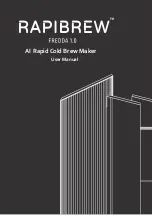
Section 8. Operation
applications.
Caution
When using the ComME communication port with non-PakBus
protocols, incoming characters can be corrupted by concurrent use of the CS I/O
for SDC communications. PakBus communications use a low-level protocol
(pause / finish / ready sequence) to stop incoming data while SDC occurs.
Non-PakBus communications include TCP/IP protocols, ModBus, DNP3, and
generic, CRBasic-driven use of CS I/O.
Though usually unnoticed, a short burst of SDC communications occurs at power-
up and other times when the datalogger is reset, such as when compiling a
program or changing settings that require recompiling. This activity is the
datalogger querying to see if the CR1000KD Keyboard Display is available.
When
DevConfig
and
PakBus Graph
retrieve settings, the CR1000 queries to
determine what SDC devices are connected. Results of the query can be seen in
the
DevConfig
and
PakBusGraph
settings tables. SDC queries occur whether or
not an SDC device is attached.
8.5
PakBus® Communications — Details
Related Topics:
•
PakBus
®
Communications — Overview
(p. 88)
•
PakBus
®
Communications — Details
(p. 393)
•
PakBus
®
Communications — Instructions
(p. 584)
•
PakBus Networking Guide
(available at
www.campbellsci.com/manuals
http://www.campbellsci.com/manuals
The CR1000 communicates with computers or other Campbell Scientific
dataloggers with PakBus. PakBus is a proprietary telecommunication protocol
similar in concept to IP (Internet protocol). PakBus allows compatible Campbell
Scientific dataloggers and telecommunication peripherals to seamlessly join a
PakBus network.
Read More
This section is provided as a primer to PakBus communications.
More information is available in the appendicies
Peer-to-Peer PakBus
Communications
(p. 584)
and Status/Settings/DTI: PakBus Information
and the
PakBus Networking Guide
, available at
www.campbellsci.com
.
8.5.1 PakBus Addresses
CR1000s are assigned PakBus
®
address
1
as a factory default. Networks with
more than a few stations should be organized with an addressing scheme that
guarantees unique addresses for all nodes. One approach, demonstrated in figure
PakBus Network Addressing
(p. 394)
, is to assign single-digit addresses to the first
tier of nodes, double-digit to the second tier, triple-digit to the third, etc. Note that
each node on a branch starts with the same digit. Devices, such as PCs, with
addresses greater than 4000 are given special administrative access to the network
PakBus addresses are set using
DevConfig
,
PakBusGraph
, CR1000
Status
table,
or with an CR1000KD Keyboard Display.
DevConfig
(
Device Configuration
Utility
) is the primary settings editor. It requires a hardwire serial connection to a
393
Summary of Contents for CR1000
Page 2: ......
Page 4: ......
Page 6: ......
Page 32: ......
Page 36: ......
Page 38: ......
Page 40: ......
Page 60: ...Section 4 System Quickstart Figure 16 PC200W View Line Graph 60 ...
Page 96: ......
Page 98: ...98 ...
Page 302: ......
Page 453: ...Section 8 Operation Figure 115 Using the Keyboard Display 453 ...
Page 456: ...Section 8 Operation Figure 118 Real Time Custom 456 ...
Page 457: ...Section 8 Operation 8 8 1 3 Final Memory Tables Figure 119 Final Memory Tables 457 ...
Page 458: ...Section 8 Operation 8 8 2 Run Stop Program Figure 120 Run Stop Program 458 ...
Page 460: ...Section 8 Operation Figure 122 File Edit 460 ...
Page 461: ...Section 8 Operation 8 8 4 PCCard Memory Card Display Figure 123 PCCard CF Card Display 461 ...
Page 478: ......
Page 506: ......
Page 536: ......
Page 636: ......
Page 642: ......
Page 644: ......
Page 676: ......
Page 677: ......















































